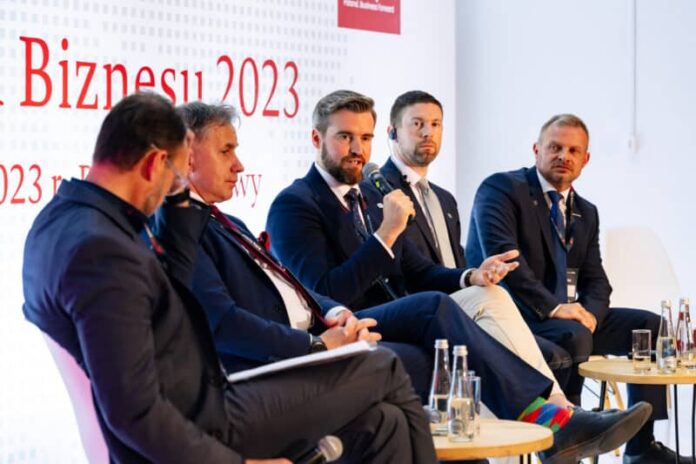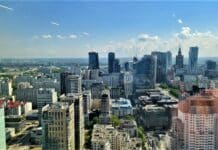Could Poland become a leading exporter of nuclear power plant modules? Americans believe so, and they are convincing more and more large entities of this idea. The demonstration module, entirely produced in our country, is the best proof that the nuclear history of Poland is beginning anew.
At the PAIH Business Forum 2023 at the PGE National in Warsaw, a panel discussion on “Energy transformation: an opportunity for the growth of competitiveness of SMEs” took place. While the participants were listening to the development prospects of Poland, there was a prototype of a nuclear reactor module in front of the stadium. Measuring 14 meters, the nuclear technology demonstrator was entirely made in Poland and is a symbol of the change that may occur in the Polish energy and industrial sector.
700 tons of iron and an underground bunker
“It’s worth seeing it before it goes underground,” noted Editor-in-Chief of Business Insider Poland, Mikolaj Kunica, who asked Michał Więcek, the president of Energoinstal SA, about the production details during the discussion. “Over 25 years, I have carried out 500 projects in the energy sector and each one was different. I can say that I have never seen such enthusiasm among my colleagues as I see now,” he said. 150 people worked on the module in the factories of the Katowice company.
Every Last Energy power plant, based on a pressurized water reactor (PWR), will consist of several dozen similar modules. The first of them may start operating in Poland in just three years. According to Więcek, there is no need to “import experts” who will manage the operation of the plant. “Remember, this has been successfully done around the world for 70 years. Our energy engineers also know how to do it because physics is the same worldwide,” he explained.
The reactor is triply secured: once it is fueled it will never be unsealed, it is surrounded by an iron bunker weighing 700 tons, and it is entirely buried in the ground. “There is no risk here, even in the event of a military conflict,” emphasized Energoinstal’s president. He also added that nuclear power, like air transport, is the safest solution worldwide, but single accidents are disproportionately highlighted.
Last Energy: We want Poland to be our European hub
The American developer of micro-nuclear power plants, Last Energy, is hopeful for mass production of PWR modules in Poland. “You have qualified staff and industrial infrastructure, and on the other hand – an energy problem. You are one of the most important partners of the USA. Is there a better place to bet on?” asked Bret Kugelmass, the company’s president rhetorically during the panel. The company is funded by Lukasz Nosk’s Gigafund, co-founder of PayPal and the first investor in Elon Musk’s SpaceX.
Kugelmass argued that mass production in the nuclear energy sector offers a chance for a significant reduction in the price of energy. “One reactor can provide a competitive price for energy, and a 19-fold increase in production allows for cutting the cost of electricity in half. And with 1000 reactors? If Germany wants, let them pay 120-150 euros per MWh, but in Poland and other countries, energy could be ten times cheaper,” presented the founder of Last Energy.
Damian Jamroz, the President of Last Energy Poland, explained that historically implemented nuclear projects do not meet the needs of entrepreneurs because they are too large, time-consuming, and require public financing. That’s why the business model of Last Energy was created. “We bring not just a design and technology, but also a product that is an investment for our partners and clients, so they can build their competitive advantage not only in Europe but worldwide thanks to access to clean, affordable and safe energy,” said Jamroz.
Small PWR reactors: A chance for a civilizational leap for 300 companies and dozens of towns in Poland
He emphasized that Polish law allows for the use of this energy source, and more than 300 companies will be able to take advantage of the crucial regulation on direct line, that is, connecting the energy source with the place of consumption, e.g., a production plant. This will eliminate the obstacle allowing entities like Last Energy to obtain a concession from the head of the Energy Regulatory Office. What’s more, the energy production process using a PWR reactor generates massive amounts of heat. Considering that most of the Polish combined heat and power plants should be replaced within the next 12 years, this technology may turn out to be a blessing for city centers.
The president of Last Energy Poland admitted that in the coming days he will hold discussions with representatives of five Polish cities. The reason? One reactor can cover the heating needs of a hundred-thousand-strong agglomeration. “Companies need to secure energy prices not only for 2-3 years, but for decades,” Jamroz pointed out. The company is implementing its business model through contracting energy in direct sales using so-called Power Purchase Agreement and thanks to its investors’ capital it is launching its operations in various markets.
It seems that the nuclear history of Poland will begin where the one based on fossil fuels ends. “Silesia will begin this transformation, because there is no other way. Our projects look into the future, we will have a hub of green economy in a closed cycle,” says the vice president of the Katowice Special Economic Zone. Rafał Żelazny admitted that for this and competitive entities, one of the priorities is to offer investors attractive access to energy. “Today, Silesia has no large power capabilities and is aware of European regulations from which there is no escape,” he added.
According to Bret Kugelmass, the serial production of SMRs in the Central and Eastern Europe region may transform the energy market worldwide. As the CEO of Last Energy assured, “this change starts here”. “Fossil fuels have led civilization to where it is now and there is no denying this. Nevertheless, to implement an adequate strategy of sustainable development responsibly, we have to move away from them, because they have become less competitive. You won’t believe how many SMRs we will build here,” added Kugelmass.


















